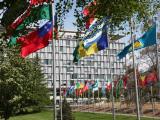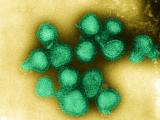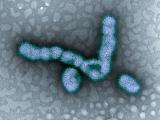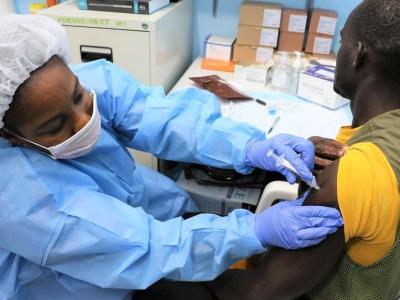Editor's note: CIDRAP News learned on Jun 10 that some of the Canadian indigenous groups that have been hit by serious cases of H1N1 influenza are not Inuit, but rather are among the groups known in Canada as First Nations or aboriginals. In particular, a Canwest News Service report referred to hundreds of cases and 20 hospitalizations at St. Theresa Point, a First Nation in northern Manitoba.
Jun 9, 2009 (CIDRAP News) – An official from the World Health Organization (WHO) said today that health experts are closely monitoring novel H1N1 influenza infections in Canada's Inuit populations, following reports that the communities are seeing more than their share of severe cases.
Keiji Fukuda, MD, told reporters at a press briefing, "We can say now that we know a larger number than expected of young Inuit people developed serious illnesses and had to get hospitalized."
He added that the WHO doesn't know if the trend is linked to socioeconomic factors, genetic factors, or chronic underlying diseases, and commented that Inuit groups were hit hard in some earlier pandemics. Fukuda is the WHO's assistant director-general for health security and the environment.
Yesterday, Joel Kettner, MD, Manitoba's chief medical officer, told reporters that 26 people were being treated in intensive care units for suspected novel influenza infections, which is unusual for an influenza outbreak, the Canadian Broadcasting Corporation (CBC) reported. He said more than half of the patients are of aboriginal descent, with an average age of 35.
Manitoba's health department said in a statement yesterday that 15 extra ventilators have arrived at the province's ICUs and that the Winnipeg Regional Health Authority is helping the departments prioritize patients and was considering deferring non-urgent surgical procedures that would normally require use of the units.
As of yesterday, Manitoba said it had confirmed 40 novel flu cases in 6 of its 11 health regions.
Meanwhile, health officials in Canada's Nunavut territory today said the number of confirmed novel flu cases has jumped from 25 to 53, with six patients in the hospital, the CBC reported. Nunavut's population is primarily Inuit.
Donald R. Olson, MPH, research director for the International Society for Disease Surveillance, based in New York City, told CIDRAP News that the severe cases in Canada's Inuit populations are puzzling. However, he added that among remote populations, the 1918 pandemic influenza was more severe and didn't follow the age patterns seen in the rest of the world.
"Inuit groups didn't show the same apparent sparing of the elderly, so possibly the older proportion of the population had not been exposed" to previous viruses related to the pandemic strain, he said.
The medical literature tells of "flu orphans" from remote Alaskan villages who survived the 1918-19 pandemic, though their parents and grandparents died, presumably because they had not been exposed to earlier H1-like viruses.
In 2006 at a state summit in Alaska, former US Health and Human Services Secretary Mike Leavitt described the impact of the 1918 pandemic virus on Alaska's native populations. "The Alaska native population in Nome was decimated—176 of the 300 Alaska Natives in the region died," he said in comments posted on the HHS pandemic flu Web site. "The pandemic swept through communities, killing whole villages."
Preexisting health conditions may also have contributed to the severity of the 1918 pandemic in Inuit populations, which also had high tuberculosis rates in the early 20th century, Olson said.
Officials don't know if higher rates of chronic illnesses in today's Inuit populations are playing a role in the high number of severe cases. However, Health Canada reports that when compared to the rest of the nation, First Nations and Inuit people have 1.5 times the rate of heart disease, 3 to 5 times the rate of type 2 diabetes, and 8 to 10 times the rate of tuberculosis infection.
Yesterday, an Australian health expert from Darwin warned that the country's indigenous populations might be at greater risk for novel H1N1 infections.
Besides citing lack of exposure to similar virus and underlying conditions as possible risk factors, experts have also theorized that remote populations might have a genetic predisposition that makes them more susceptible to the virus, Olson said. But he expressed doubt that the factor is playing a role in Canada's current outbreak.
The signals coming out of Canada are worrying, he said. "The less developed world may have a terrible experience with this, though there is a lot of coughing and sneezing in the rest of the world," Olson said.
Danuta Skowronski, MD, a physician and epidemiologist at the University of British Columbia, told CIDRAP News that over the past few years, circulation of seasonal H1N1 viruses in North America has been patchy, and people in remote communities are likely to have had less exposure to the viruses than have people living in urban settings.
There's still much that researchers don't know about possible cross-protection against the novel H1N1 virus from exposure to previous H1N1 strains, she said. Though researchers have identified antibody markers and determined that seasonal vaccination offers little protection, they still haven't gauged the cell-mediated response—which can offer protection during severe infections—afforded by exposure to previous H1N1 strains, Skowronski added.
Public health officials will also be looking for environmental factors that might be contributing to the infections in the First Nations and Inuit groups, she said. For example, large numbers of people living in one household may have greater exposure to the virus. "This all needs to be assessed, because we're picking up possible signals of concern," Skowronski said.
See also:
Jun 8 Manitoba press release
Health Canada disease and health condition statistics
Ahmed R, Oldstone MBA, Palese P. Protective immunity and susceptibility to infectious diseases: lessons from the 1918 influenza pandemic. Nature Immunol 2007 Nov;18(11):1188-93 [Abstract]


















